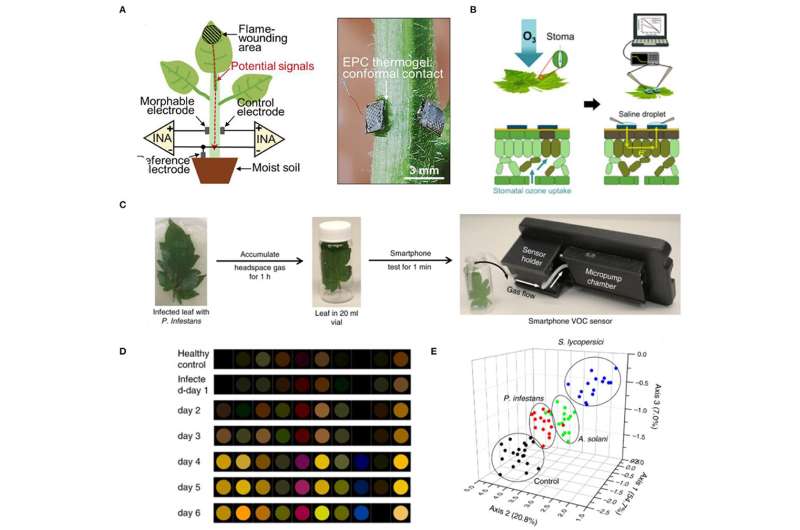Promising uses of non-destructive sensors to aid food security and enhance sustainable agriculture

Researchers from the Disruptive & Sustainable Technologies for Agricultural Precision (DiSTAP) Interdisciplinary Research Group (IRG) at the Singapore-MIT Alliance for Research and Technology (SMART), MIT's research enterprise in Singapore, and their local collaborators from the Institute of Materials Research and Engineering (IMRE), Agency for Science, Technology and Research (A*STAR) as well as the Department of Chemical and Biomolecular Engineering (ChBE), National University of Singapore (NUS) have published a review that discusses the recent advances in non-destructive plant health monitoring, ranging from electrochemical-based arrays to nanosensors and electronic noses, and why tracking plant health is an attractive and sustainable strategy that can be used to optimize crop growth practices. The review aims to inspire future developments of non-destructive technologies for plant health diagnosis.
To meet the pressing need for global food security and pave the way for sustainable agriculture, the advancement and adoption of agricultural technology are critical in alleviating the conditions of 193 million people in the world who are acutely food insecure. However, sustainable practices need to be implemented to minimize environmental destruction when improving crop yields and productivity. Traditionally, farmers will often only be able to notice signs of their crops' health deteriorating at a stage where reparative measures are limited.
Additionally, the current testing via chromatography-based analytical techniques is destructive as it requires, punching out leaf samples that would cause wounding and tissue breakdown. These methods are also laborious, including lab-based extraction and processing of multiple plant samples for every data point. Thus, scientists have been advancing the field of precision agriculture, developing novel sensors and analytical tools to help farmers guide farm-management decisions. The use of non-destructive or minimally invasive sensors for plant metabolites has emerged as an essential analytical tool for real-time monitoring of plant signaling pathways and plant response to external conditions that indicate overall plant health. These sensors could be incorporated into future farming practices and implemented in high-tech urban farms that use precision, predictive and environmentally controllable farming.
"In light of the increasing demand for food due to the growing global population and concern over food security, developing innovative and sustainable technologies and tools to improve crop yield and quality is timely and essential. Non-destructive plant health monitoring stands as one of the key strategies for improving crop growth practices, complementing current agricultural techniques such as crop rotation, intercropping and genetic modification," said Dr. Gajendra Pratap Singh, Principal Investigator and Senior Scientific Director at DiSTAP.
The team explained their research in the review article titled "Non-destructive Technologies for Plant Health Diagnosis", published in the journal Frontiers in Plant Science. The findings showed that the sensors could be broadly categorized into those that detect internal (in vivo sensors) and external (plant surface and airborne) signaling molecules.
In vivo sensors are based on either electrochemical sensors or plant nano-bionic sensors. Recent nanotechnology advances have enabled electrochemical and plant nano-bionic sensors to exhibit higher sensitivity and selectivity by utilizing unique electrochemical and optical properties. Besides internal signaling molecules, plants also emit signals at the surfaces of their organs as well as through airborne metabolites such as volatile organic compounds (VOCs) for inter-plant communication. Detection of internal and external cues, such as surface and airborne compounds, allows for the non-invasive and real-time diagnosis of plant diseases.
Furthermore, the sensors convert plant signals into digital signals to establish direct communication between plants and growers. "By tapping into plants' physiological events in real-time, non-destructive sensors enable prompt adjustment of environmental conditions to augment crop productivity while minimizing resource use," added Dr. Tedrick Thomas Salim Lew, Scientist at A*STAR's IMRE and Adjunct Assistant Professor at NUS ChBE, who was the corresponding author of the article.
"The review gave insights into sensors which are versatile and have been successful in extracting spatiotemporal information from a variety of agriculturally important plant species. The sensors will open the possibility of real-time feedback control schemes that can aid in the precise application of fertilizers and plant growth regulators to maximize growth, as well as facilitate timely intervention to minimize yield loss from plant stress," said Mervin Ang, Research Scientist at DiSTAP and first author of the article.
To address profound challenges in food production in Singapore and the world, DiSTAP has, over the years, introduced novel analytical tools that are rapid, non-destructive and have the ability to detect and provide information from living plants in real-time. This latest review seeks to advance technologies which can be applied to study agriculturally relevant crops in the field, bridging the knowledge gap between model plants commonly used in plant biology and economically important crops.
More information: Mervin Chun-Yi Ang et al, Non-destructive Technologies for Plant Health Diagnosis, Frontiers in Plant Science (2022). DOI: 10.3389/fpls.2022.884454
Journal information: Frontiers in Plant Science





















